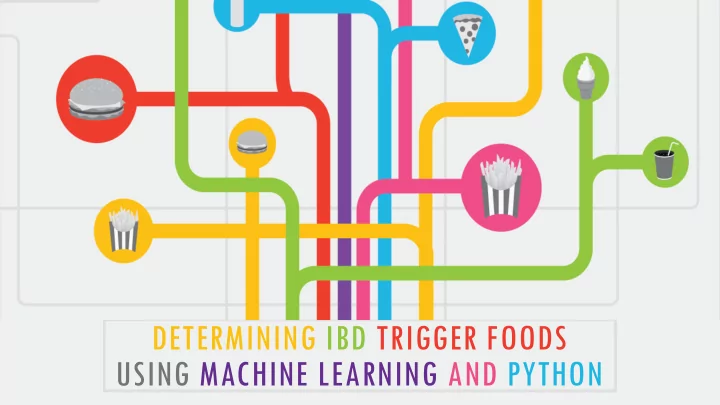

DETERMINING IBD TRIGGER FOODS USING MACHINE LEARNING AND PYTHON
WHAT’S IBD? • Inflammatory bowel disease (IBD) describes a group of conditions, including Ulcerative Colitis (UC) and Crohn’s disease (CD), impacting 1.6 million people in the US alone. • Characterized by “gut” inflammation. • Symptoms range from mild annoyances to life- threatening issues (blockages, cancer). • Autoimmune, caused by a combination of genetic and environment factors.
WHAT’S FOOD GOT TO DO WITH IT? • While foods’ relationship with IBD remains understudied and controversial… • …57% of IBD sufferers think diet can trigger symptom flare… • …leading to food avoidance/malnourishment. • Safe foods are thought to be person specific, in contrast to diseases like Celiac or lactose intolerance, where food issues are known.
WHY IT’S PERSONAL TO ME? Real ulcers are gross, so here’s some clipart: • In February 2016 I was diagnosed with Crohn’s disease... and 10 ulcers. • Medication has me ulcer free, but not symptom free. • Certain foods can trigger flares lasting weeks. • Trial and error to find safe foods is painful You’re welcome. and takes a long time.
GOAL – WHAT CAN IBD SUFFERERS EAT? 1) Sub-clusters of diet? 2) Relationships between individual foods or groups of foods? 3) Nutrients that impact food tolerance? 4) Can food tolerance/intolerance be predicted with a reasonable degree of accuracy for an IBD sufferer with only a few “known” safe/unsafe foods?
MATERIALS • Small data set: 670, 250-food survey responses from IBD sufferers about food tolerances. 570 usable. • Nutrient information for each surveyed food from the USDA’s nutrient database API. • Python 3.6.1 and Jupyter Notebook • Analysis: apyori, numpy, pandas, PyFIM, scikit-learn, scipy, sqlite • Visualization: graphviz, matplotlib, seaborn The [online] survey utilizes a sliding scale to accept answer inputs, which are stored as integer values in a range from 0 through 10. A checkbox for each question gives the option to not answer questions individually.
ANALYSIS – ASSOCIATION RULE LEARNING • A rule-based machine learning method for discovering interesting patterns between variables in large databases, in a human-understandable way. Two steps: • Frequent Itemset Mining (FIM). Find all “frequent” subsets, generally as measured by a Support threshold. • Rule Generation. Generate “interesting” rules, commonly as measured by Confidence and Lift. • Uses: market basket analysis, web mining, document analysis, telecommunication alarm diagnosis, network Check out Introduction to Data Mining by Tan, intrusion detection, bioinformatics Steinbach, and Kumar, Chapter 6 for an introduction to the basic concepts (free online).
FP-GROWTH FOR THE EFFICIENCY WIN • Brute forcing FIM is exponential - O(2^n) • FP-Growth is quadratic - O(n^2) 1. [Iteratively] build compact data structure 2. [Recursively] extract frequent itemsets • Downside: Complicated • Many wrong implementations in Python • Used PyFIM – some limitations, but accurate Check out Machine Learning in Action by Peter Harrington, Chapters 11+12 for step-by-step fp- growth code in Python.
[SEMI-]NOVEL APPROACHES 1. Logically ternary data instead of binary Adds information, but creates conflicts New method of conflict resolution needed 2. Monte Carlo cross-validation Association Rule Learning is inherently self validating, but need model comparability Evaluation method (accuracy) determined by applicable subsets of rules, per tested transactions
VALIDATION
RESULTS • Recommendations at least 80%+ accurate, usually 90%+ • Average 18-19 new recommendations pp. • Commonly recommended foods: leeks, lettuce, garlic, honeydew melon, cod, cantaloupe, chicken eggs, basil, cucumber, white potatoes. • Commonly conflicting foods: fruit, dairy, cruciferous vegetables
THE FULL MODEL 888,926 rules generated Rules for 74% of possible recommendations, with >80% confidence Can eat rules: animals, ‘staple’ veges (carrots, cucumber, lettuce, tomato, potato), white rice Can’t eat rules: apple juice, coffee, cola, raisins Cut rules: not alcohol of various types
IBDALIZER • Recommendation tool using input survey data • Background output: Me!
FUTURE WORK • Update survey for recommendations • Integrate live recommendation system into the survey (with feedback and “learning”) • Apply more advanced association techniques , including hierarchical and clustering • Use my USDA nutrient database tool to identify relevant nutrients
THANK YOU! ED My Mentor GROSS ANDRA STANCIU CHRIS GRUBER LAUREL RUHLEN Check out the full project git.io/vbzD2 CHIPY zaxrosenberg.com/blog & IBDrelief.com
Recommend
More recommend